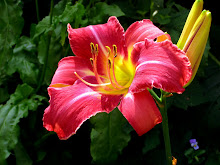
Maybe you’ve hit a few end-of-season sales at your favorite nurseries, but didn’t get around to getting the plants in the ground in time. Or perhaps you have some perennials in ceramic deck pots. There’s any number of reasons why you might have some potted perennials hanging about, and you’re not sure how to get them through the winter successfully.
For several years I’ve overwintered 100-200 potted perennials – some of them grown from seed the spring before, some are on their way to being large 2- and 3-year-old plants, and yet others are divided daylilies that will double by next summer. After reading all kinds of advice, talking with large nursery workers, and trying different methods over the years, I’ve found what works the best for me. Maybe it will be useful to you.
The types of northern perennials we’re talking about cannot be brought into the house – they need the cold/freezing temperatures of winter to go dormant. But potted plants tend to circle their roots around the outer edges of the pot, and so often there’s only a thin wall of plastic separating them from the cold, cruel winter world. Repeated freeze/thaw cycles can damage the roots; so can rodents, rot, all sorts of things. And, of course, if they’re in ceramic pots, as is often the case with deck plants, the combination of precipitation and freezing temperatures can crack and shatter the pot.
So here’s what works for me:
First of all, keep watering if there's little or no rain. It’s soooo easy to forget about this once the season winds down, but even as these plants are shifting into dormancy, the roots need that moisture. They are still alive, and dried-out potted plants freeze much more rapidly than moist ones, and suffer more easily. A dried-out plant will not survive the winter.
Once the tops die back, trim them back.

And then, once the weather has finally turned cold and you’ve had a good sharp frost, move the moist potted plants into a dark, unheated space; a garage, a shed, a barn, an unheated porch. The idea is to keep them frozen, or at least very, very cold, and out of the warming rays of the sun. You’re trying to avoid the thaw/freeze/thaw cycle that would occur if they were left outdoors. You can cover them if you like, but if there are any little critters around, they’ll gravitate towards that nice dark protected space and may well gnaw their way through the roots of the plants – at least, that’s what’s happened here in the past.
Yes, you can stack them one on top of the other to conserve space; it won’t hurt them.
In the spring, when the weather begins to warm and the perennials in your garden are showing growth, when the worst of the deep freeze is over, you can begin to move your pots outdoors again. This is a little tricky – there are always those spring snowstorms and freezes – but perennials are pretty hardy; just watch out for terribly frigid temps, and for precipitation followed by a freeze that doesn’t allow the water to drain out of the pots; that could encourage rot. I tend to move maybe a quarter of my plants outdoors at a time, spacing the migration over a period of several weeks, just because I’m on the cautious side.
Even under the best of circumstances, you might lose a few. But with the method I've described, I now get about a 90% survival rate in my cold Zone 5b -- I'm happy with that.
One more thing: the larger the pot, the better the chances of survival, I've found. Small plants with small root systems in small pots just have a harder time of it. It's not too late to plunk them into a larger pot, at least to give the roots more insulation.

No comments:
Post a Comment